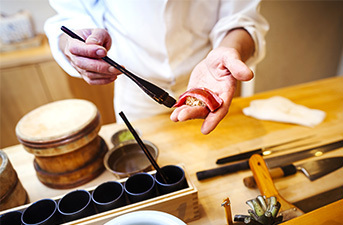Restaurants(3872)
Sukiyaki Harijyu Dotonbori
Situated in the middle of Osaka’s Dotonbori entertainment district, this sukiyaki restaurant has been serving customers with high-quality wagyu beef hotpot for over 100 years.
Minokichi Takeshigero Hotel Granvia Kyoto
The Hotel Granvia Kyoto plays host to one of Kyoto’s most historic kyo-kaiseki restaurants, with over 300 years of history serving freshwater fish and other traditional dishes.
Kuramoto Saryo
Operated by Ishikura Shuzo, the last remaining sake brewery in Hakata, Kuramoto Saryo serves as a cornerstone of kaiseki and sake-making and resides in the former residence of the brewery's owner.traditions in Fukuoka.
Sushi Kimura Nihombashi
One city’s loss is another’s gain. Following a 15-year stint at one of New York City’s most exclusive sushi restaurants, Kimura Koji arrives in Nihonbashi with an Edomae omakase concept shaped by fish from his hometown in Hachinohe.
Beef Nagayoshi
Opened in 2014 in Shinjuku’s Arakicho, Beef Nagayoshi serves an approachable A5-grade wagyu omakase course, with the owner handling all the grilling and dining is done at izakaya-style counter seating.
Sushi Aoyagi
Local legend Sushi Aoyogi debuted following The Tokyo Station Hotel’s renovation, serving technique-driven, quality-focused Edomae omakase to both the city's old and new crowds just steps from Tokyo Station’s historic red-bricked structure.
Trattoria Buca’Massimo
The highlight of this Michelin Bib Gourmand restaurant is the bistecca alla fiorentina, a traditional Tuscan steak weighing up to 800 grams, and measuring up to four centimeters thick.

La Bettola da Ochiai
Founded by the grandfather of Italian cuisine in Japan, La Bettola da Ochiai is known by Japanese foodies for being the hardest restaurant to book in the entire country.

Hamacho Kaneko
A veteran of the Michelin restaurant Ishiusubiki Teuchi Kyorakutei, Chef Kaneko Yasushi wears his own Michelin awards with quiet pride. Soba, tempura, appetizers and sake are aplenty at his Hamacho restaurant.
Bistro Glouton
This Ikejiri-Ohashi restaurant run by a husband-wife duo offers the quintessential French bistro experience. Classic French fare like duck confit and ratatouille employs the best of Japan’s seasonal produce.
Lien
Offering courses of flavor and sentiment, the Michelin-recognized Lien offers an intimate, insightful French dining experience. All courses are made using fresh ingredients from the chef’s hometown in Aomori for a personal touch.

L'AS
A recipient of the Michelin Bib Gourmand, this Minami-Aoyama restaurant has made a name for itself with its simple dishes that belie the complexity of flavors within.

Matsunozushi
The Michelin-recognized craftsmanship behind Matsunozushi’s classic Edomae-style sushi, paired with a homely atmosphere, makes this tiny Shiinamachi restaurant a must-visit for avid sushi fans.

Tonkatsu Narikura
The characteristic white color of the tonkatsu batter at this Minami-Asagaya restaurant comes from a low-temperature frying process that gives the pork maximum juiciness — and a Michelin Bib Gourmand award.
Tohakuan Karibe
The highlight of this Michelin Bib Gourmand soba restaurant is its extensive wine selection, which changes every week at the recommendation of a sommelier. Seasonal tempura offerings keep guests coming back for more.
Yakiniku Kokonomi
This Ebisu yakiniku restaurant’s name literally means “only here”, referring to its claim to serve the “original” wagyu beef — Takenotani-tsuru beef from Okayama — that can only be eaten there.
Hiroshima Yagumo
This Hiroshima hotpot restaurant was serving shabu-shabu before it was even called shabu-shabu. Tuck into the finest Japanese beef dipped in a homemade sauce, all while surrounded by traditional Japanese folk art.
Yagumo Nagarekawa
At the Nagarekawa branch of one of the first restaurants to serve shabu-shabu, guests can enjoy the finest kuroge wagyu black beef in a homemade sauce, all while surrounded by traditional Japanese folk art.
Wagyu Amiyaki Kaiseki Sizzler
For over 50 years, this Hiroshima yakiniku restaurant has offered 25 different cuts of beef from every possible part of the cow. Each one is kuroge wagyu black beef from the Hiroshima region for maximum freshness.
Teppanryori Mimitei
Discover Hiroshima’s best-kept secret at this teppanyaki restaurant: Hiroshima beef, which has a melting point so low it literally melts in the mouth.
Shunsai Hayato
Cuisine fit for a king. Near the Korakuen Gardens, this Okayama restaurant keeps the cuisine of the feudal lords of fine otonosama-ryori alive. Feast on fresh sashimi and Chiya beef, a wagyu cattle so rare it bears the title of “phantom wagyu”.
Sumiyaki Kaminari Main Store
This legendary Hiroshima yakitori restaurant uses a combination of “tohbi” distant-fire charcoal grilling to seal in the flavor, as well as a tashi-tsugi sauce that has been continuously added to for over 40 years of operation.
Sumiyaki Kaminari Tatemachi
This legendary Hiroshima yakitori restaurant uses a combination of “tohbi” distant-fire charcoal grilling to seal in the flavor, as well as a tashi-tsugi sauce that has been continuously added to for over 40 years of operation.
Robataya Jiro
This Oku-Kagurazaka robatayaki restaurant offers the freshest fish from all over the country and Omi wagyu beef, prepared by a chef with decades of experience in a number of different culinary styles.
Hakata Nakasu Rokusantei
With over 60 years of history, this Nakasu riverside restaurant serves the deadly poisonous fugu in various forms from hotpot to sashimi, alongside other local Fukuoka delicacies. Expert chefs prepare it at the counter right before guests’ eyes.
Kagurazaka Tempura Tenko
Chef Arai Hitoshi’s family has been making tempura at his Kagurazaka restaurant for almost 50 years, and he has lectured on the subject from Paris to New York. His secret ingredient? A focus on hospitality.
Minokichi Shinsaibashi Midosuji
The best of seasonal Kyoto-style cuisine rightfully enjoyed in traditional, folk-craft-filled dining rooms.
Shimakawa
This Hakata restaurant has "conveying the seasons" with fresh seafood from the Genkai Sea for over 30 years, with local delicacies at the forefront like pufferfish, longtooth grouper, pike conger and devil stinger.
